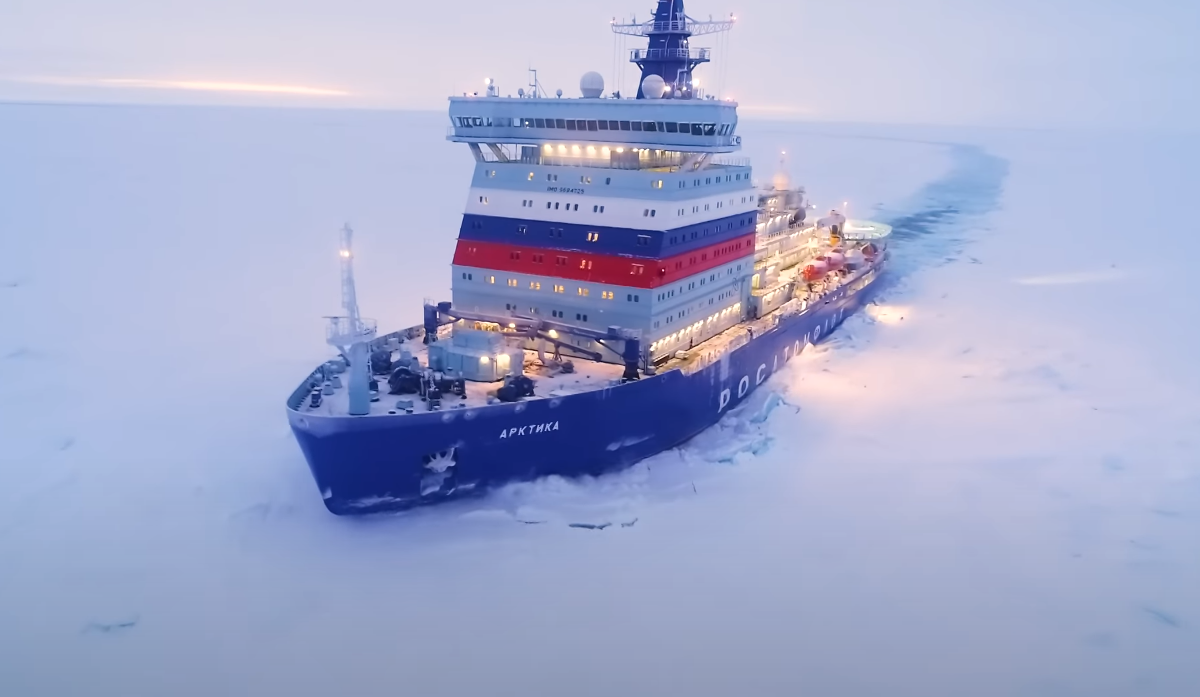Design
A five-deck vessel has a superstructure with the same number of tiers. The body is made of extra strong alloyed steels, and where it is subjected to the greatest pressure from the outside, it is additionally equipped with a so-called. ice belt. A nuclear reactor that generates steam is located in the very center of the ship, in a protected compartment.
 The icebreaker was renamed twice. Photo: YouTube.com
The icebreaker was renamed twice. Photo: YouTube.comTo control the technical means of the power plant, the automatic mode is used: there is no need to keep watch in the engine room.
General control over the operation of the reactor is carried out from the central post. The icebreaker is controlled from the wheelhouse located across the ship. It is approximately 25 m long and 5 m wide. Main technical data:
✅ length, width, side height - 148, 30 and almost 17 m
✅ displacement - 23460 tons with a draft of 11 m
✅ power plant - a reactor with a capacity of 75 thousand liters. with., connected with three screws with a fixed pitch
✅ maximum speed - 38,5 km / h
✅ duration of swimming - up to 7,5 months.
✅ number of crew members - 150 sailors
It is worth noting that even then it was clear that a more powerful icebreaker was required to ensure longer navigation along the NSR.
Hike to the North Pole
At the end of the summer of 1977, the ship left Murmansk for Novaya Zemlya and, having reached the Laptev Sea, headed for the "crown" of the planet. In less than eight days of navigation, the ship, having traveled 2528 miles, recorded its stay at the North Pole. A 10-meter flagpole was placed there, on which the scarlet banner of the USSR was hoisted. Under the ice, the sailors lowered a steel tile with the image of the state symbol - the country's coat of arms and a commemorative inscription about the icebreaker's stay at a latitude of 90 °.
 In honor of the ship's conquest of the North Pole, postage stamps and blocks were issued. Photo: YouTube.com
In honor of the ship's conquest of the North Pole, postage stamps and blocks were issued. Photo: YouTube.comBut this is not the only notable achievement of the ship. Earlier, in 1975, it sailed the Admiral Makarov diesel ship along the NSR towards America. A year later, the icebreaker "Ermak" was rescued, unable to navigate the dry cargo ship "Captain Myshevsky" on its own. Later history repeated itself with the same ships "Leningrad" and "Chelyuskin". In 1983, the nuclear-powered ship took part in an operation to lay a path in the ice for 57 (!) stuck ships, including the Lenin, which also ran on nuclear fuel. For the "Arktika" this time was truly "stellar".
 In terms of power and dimensions, the Arktika was superior to the Lenin icebreaker. Photo: YouTube.com
In terms of power and dimensions, the Arktika was superior to the Lenin icebreaker. Photo: YouTube.comHowever, “age takes its toll” and in 2008 the nuclear-powered ship was put on hold. And in July 2012, he was excluded from the Register. The Soviet, and then the Russian "Arktika", without entering the home port of Murmansk, worked for a whole year (from May 4 to 4, 1999-2000) in the Arctic Ocean, guiding 110 ships through the ice along the NSR. During this time, the ship passed 50 thousand miles without any significant damage. By 1999, the Arktika had covered 1 million nautical miles.
Follower of the same name
In October last year, in Murmansk, from where the predecessor of a modern ship once set off for the North Pole, an act of acceptance and transfer of the new Russian nuclear-powered icebreaker Arktika was signed. He was given exactly the same name as his famous predecessor. Technical characteristics of the new nuclear-powered ship:
✅ length, width, side height - 173,3, 34, 15,2 meters
✅ minimum draft - 8,55 m
✅ displacement - 33,54 thousand tons
✅ duration of autonomous navigation - more than a year
✅ breaking ice thickness - up to 2,9 m
✅ number of crew members - 75 sailors
✅ service life - 40 years
The main feature of the vessel is its “ability” to change the draft, which is important when working at shallow depths, for example, in estuaries. For this, ballast tanks are used. The new ship of project 22220 was laid down five years after the end of the operation of the older "namesake", in 2013. Construction progressed slowly: ties with Ukraine, which supplied various units for icebreakers, were broken.
The last nuclear-powered ship of the USSR was laid down in 1989 and completed after 18 (!) years, launched in 2007. Initially bearing the name "Ural", it entered into operation under the name "50 Years of Victory".
 "Arktika" was also built for a long time. Photo: YouTube.com
"Arktika" was also built for a long time. Photo: YouTube.comSea trials of the new Arktika started at the end of 2019. The verification was carried out in several stages. First in the waters of the Gulf of Finland, then in the Baltic Sea. Until September of the next move, the units and mechanisms of the ship were tested, which even got into a storm. In the same month, the successful completion of the inspections was officially announced. Then the "Arktika", crossing four seas, arrived in Murmansk.
 Here they monitor the "well-being" of a nuclear reactor. Photo: YouTube.com
Here they monitor the "well-being" of a nuclear reactor. Photo: YouTube.comCaptain Oleg Shchapin, who tested the ship in different modes, noted that real ice tests are ahead. It was simply not possible to find a suitable ice floe, and those that came across, a meter thick, the nuclear-powered ship simply “did not notice”. As for the hummocks, the "Arktika" passed through them "without moving", in contrast to the ship "50 Years of Victory", which was tested by the same person.
 The Arktika is the coolest ship on the Northern Sea Route. Photo: YouTube.com
The Arktika is the coolest ship on the Northern Sea Route. Photo: YouTube.comToday, the nuclear-powered icebreaker is working on the expanses of the Northern Sea Route, escorting ships. So, in December last year, the Arktika, leaving Arkhangelsk, saw off the ships Kapitan Dranitsyn, Yuri Arshenevsky, Polar King and Engineer Trubin. In January 2022, the caravan delivered 14 thousand tons of cargo (mainly building materials) to the port of Pevek in Chukotka. With the new nuclear-powered ship, the last two ships set off back.
Other icebreakers of project 22220
"Siberia" was laid down in May 2015, after a couple of years it was launched. The ship also has its "namesake twin" in the past. The vessel with the same name was put into operation at the end of 1977, and it also visited the North Pole in 1987. The ship has now been scrapped.
 40 years after the start of the work of the Soviet "Siberia", a new, Russian one was launched into the water. Photo: YouTube.com
40 years after the start of the work of the Soviet "Siberia", a new, Russian one was launched into the water. Photo: YouTube.comHis follower, laid down in 2015, solemnly “got into service” on 25.01.2022/XNUMX/XNUMX. The nuclear-powered ship arrived in Murmansk from St. Petersburg, having managed to visit (safely) in a storm. And at the end of January he went on his first flight. "Brother" "Arctic" has the following parameters:
✅ length, width, side height - 173,3, 34 and 15,2 m
✅ displacement - 33,54 tons
✅ maximum speed - 34 knots
✅ minimum draft - 9,03 m
✅ power plant power on the shafts - 60 MW
✅ number of crew members - 54 sailors
The resource of the nuclear icebreaker "Sibir" declared by the manufacturer is at least 40 years. Another ship from this family, the Ural, is scheduled to be commissioned by the end of this year. According to information received in April from A. Bezprozvannykh, deputy head of the Ministry of Industry and Trade, the ship was built "by 85%."
 Launching of the nuclear-powered ship "Ural" (2019). Photo: YouTube.com
Launching of the nuclear-powered ship "Ural" (2019). Photo: YouTube.comThe fourth vessel of series 22220 Yakutia was laid down in May 2020. It is assumed that the ship will be handed over to the customer towards the end of 2025. And one more nuclear-powered ship "Chukotka", which is under construction, will be put into operation tentatively during 2026. They also continue to assemble the world's widest and most powerful icebreaker "Leader". According to the forecasts of the Ministry of Industry and Trade, sanctions risks in relation to ships on the stocks are moderate. Most of the equipment is produced at Russian related enterprises and companies subordinate to Rosatom.










